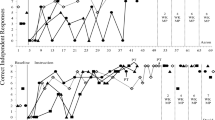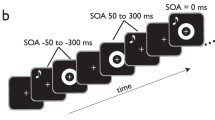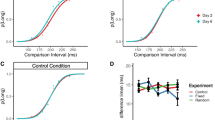Abstract
The present study Investigated the relationship between the shape and location of multistimulus prompts and the distinctive features of task stimuli as an important variable for establishing a difficult form discrimination through time delay. The subjects in the two experiments of the study were 4- and 5-year-old children. Two color cues were used in each of the four conditions in Experiment 1, one for prompting responding to the S+ and one for preventing responding to the S-. The prompts had either the same shape as the distinctive features of the task stimuli or a different shape, and they were presented next to or distant from these features. The results show that most subjects learn the task only when the shapes and locations of the prompts correspond with those of the critical features of the task stimuli. Experiment 2 investigated whether a complete spatial unification of the prompts with the distinctive features of the task stimuli would further increase the efficacy of time delay. Two conditions were used, one in which the prompts were presented at the very same locations as the critical features (unified prompts) and one in which they were presented next to these features (juxtaposed prompts). The results show no significant differences between conditions. Both conditions result in most or almost all subjects learning the task.
Similar content being viewed by others
References
AESCHLEMAN. S. R., & HIGGINS, A. F. (1982). Concept learning by retarded children: A comparison of three discrimination learning procedures. Journal of Mental Deficiency Research, 26, 229–238.
BRADLEY-JOHNSON, S., SUNDERMAN, P., & JOHNSON, C. M. (1983). Comparison of delayed prompting and fading for teaching preschoolers easily confused letters and numbers. Journal of School Psychology, 21, 327–335.
BROWN, C. H., & RILLING, M. H. (1975). Stimulus display and the reduction of errors in the transfer of stimulus control. Animal Learning and Behavior, 3, 21–27.
DORAN, J., & HOLLAND, J. G. (1979). Control by stimulus features during fading. Journal of the Experimental Analysis of Behavior, 31, 177–187.
EGELAND, B. (1975). Effects of errorless training on teaching children to discriminate letters of the alphabet. Journal of Applied Psychology, 60, 533–536.
ETZEL, B. C., & LeBLANC, J. M. (1979). The simplest treatment alternative: The law of Parsimony applied to choosing appropriate instructional control and errorless-learning procedures to the difficult-to-teach child. Journal of Autism and Developmental Disorders, 9, 361–382.
KOEGEL, R. L., & LOVAAS, O.I. (1978). Comments on autism and stimulus overselectivity. Journal of Abnormal Psychology, 5, 563–565.
KOEGEL, R. L., & RINCOVER, A. (1976). Some detrimental effects of using extra stimuli to guide learning in normal and autistic children. Journal of Abnormal Child Psychology, 4, 59–71.
LANCIONI, G. E., & SMEETS, P. M. (1986). Procedures and parameters of errorless discrimination training with developmentally impaired individuals. In N. R. Ellis & N. W. Bray (Eds.), International review of research in mental retardation-Volume 14 (pp. 135–164). New York: Academic Press.
MacDONALL, J., & MARCUCELLA, H. (1976). Cross-modal transfer of stimulus control in the albino-rat: A stimulus-display procedure. Animal Learning and Behavior, 4, 341–346.
NELSON, D. L., GERGENTI, E., & HOLLANDER, A. C. (1980). Extra prompts versus no extra prompts in self-care training of autistic children and adolescents. Journal of Autism and Developmental Disorders, 10, 311–321.
RICHMOND, G., & BELL, J. (1983). Comparison of three methods to train a size discrimination with profoundly mentally retarded students. American Journal of Mental Deficiency, 87, 574–576.
RINCOVER, A. (1978). Variables affecting stimulus fading and discrimination responding in psychotic children. Journal of Abnormal Psychology, 87, 541–553.
SAUNDERS, R. R., & SPRADLIN, J. E. (1985). A systematic analysis of transfer of control in the delayed prompt procedure. Paper presented at the Association of Behavior Analysis Convention, Columbus, Ohio.
SCHREIBMAN, L. (1975). Effects of within-stimulus and extra-stimulus prompts on discrimination learning in autistic children. Journal of Applied Behavior Analysis, 8, 91–112.
SCHREIBMAN, L., & CHARLOP, M. H. (1981). S + versus S — fading in prompting procedures with autistic children. Journal of Experimental Child Psychology, 31, 508–520.
SCHREIBMAN, L., CHARLOP, M. H., & KOEGEL, R. L. (1982). Teaching autistic children to use extra-stimulus prompts. Journal of Experimental Child Psychology, 33, 475–491.
SMEETS, P. M., HOOGEVEEN, F. R., STRIEFEL, S., & LANCIONI, G. E. (1985). Stimulus overselectivity in Tmr children: Establishing functional control of simultaneous multiple stimuli. Analysis and Intervention in Developmental Disabilities, 5, 247–267.
SMEETS, P. M., & LANCIONI, G. E. (1981). The efficacy of three procedures for teaching easy and difficult discriminations in severely retarded adolescents. Behavior Research of Severe Developmental Disabilities, 2, 191–201.
SMEETS, P. M., LANCIONI, G. E., & HOOGEVEEN, F. R. (1984). Effects of different stimulus manipulations on the acquisition of word recognition in trainable mentally retarded children. Journal of Mental Deficiency Research, 28, 109–122.
SMEETS, P. M., LANCIONI, G. E., STRIEFEL, S., & CURFS, P. G. M. (1986). Establishing a difficult discrimination through time delay: Are the dimensions of the prompts critical? Manuscript submitted for publication.
SMEETS, P. M., & STRIEFEL, S. (1976a). Acquisition of sign reading by transfer of stimulus control in a retarded deaf girl. Journal of Mental Deficiency Research, 20, 197–205.
SMEETS, P. M., & STRIEFEL, S. (1976b). Acquisition and cross modal generalization of receptive and expressive signing skills in a retarded deaf girl. Journal of Mental Deficiency Research, 20, 251–260.
SPRADLIN, J. E. (1985). Delayed prompts: Problems in replication. Paper presented at the Association of Behavior Analysis Convention, Columbus, Ohio.
STRIEFEL, S., BRYAN, K. S., & AIKINS, D. (1974). Transfer of stimulus control from motor to verbal stimuli. Journal of Applied Behavior Analysis, 7, 123–135.
STRIEFEL, S., WETHERBY, B., & KARLAN, G. R. (1976). Establishing generalized verb-noun instruction-following skills in retarded children. Journal of Experimental Child Psychology, 22, 247–260.
TOUCHETTE, P. (1968). The effect of graduated stimulus change on the acquisition of a simple discrimination in severely retarded boys. Journal of the Experimental Analysis of Behavior, 11, 39–48.
TOUCHETTE, P. (1971). Transfer of stimulus control: Measuring the moment of transfer. Journal of the Experimental Analysis of Behavior, 15, 347–354.
TOUCHETTE, P., & HOWARD, J. S. (1984). Errorless learning: Reinforcement contingencies and stimulus control transfer in delayed prompting. Journal of Applied Behavior Analysis, 17, 175–188.
WOLFE, V. F., & CUVO, A. J. (1978). Effects of within-stimulus and extra-stimulus prompting on letter discrimination by mentally retarded children. American Journal of Mental Deficiency, 83, 297–303.
Author information
Authors and Affiliations
Additional information
Appreciation is expressed to Tjeerd Anema, Pierre Kemmere, Trudie Klooster, and Jeltje van der Steen for their assistance.
Rights and permissions
About this article
Cite this article
Smeets, P.M., Lancioni, G.E. & Striefel, S. Discrimination Training Through Time Delay of Multistimulus Prompts: The Shapes and Locations of the Prompts. Psychol Rec 37, 507–521 (1987). https://doi.org/10.1007/BF03394996
Published:
Issue Date:
DOI: https://doi.org/10.1007/BF03394996




